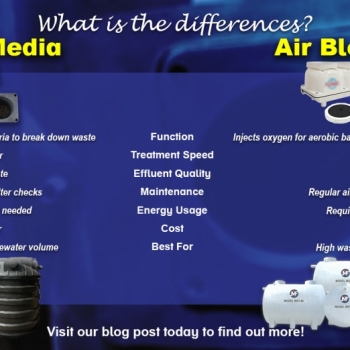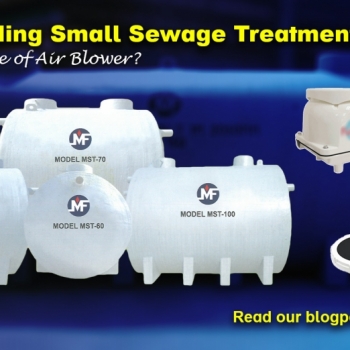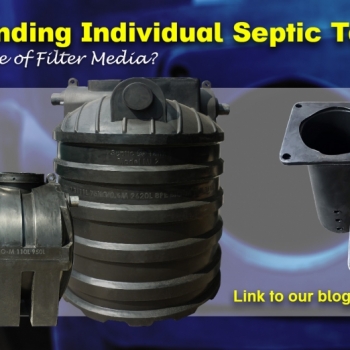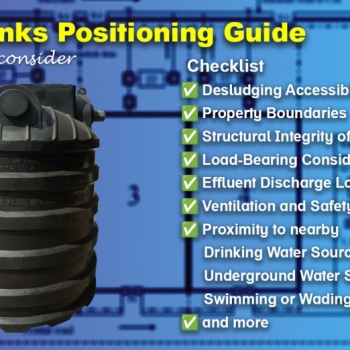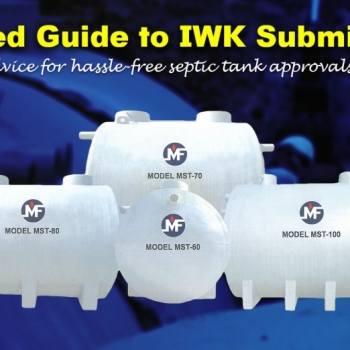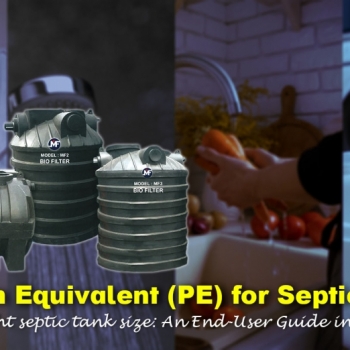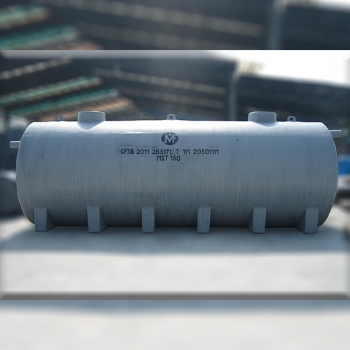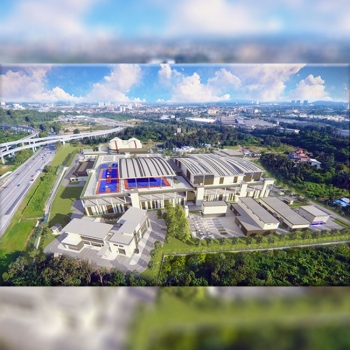Choosing between an individual septic tank with filter media and a mechanical septic tank with an air blower depends on efficiency, cost, and maintenance. This article breaks down their key differences to help you select the right wastewater treatment solution.
Understanding Biodegradable Septic Tanks: A Guide in Malaysia
11 Nov 2024
Understanding Biodegradable Septic Tanks: Are They Right for Malaysia?
- Key Takeaways
- What is a Biodegradable Septic Tank?
- Cost of Biodegradable Septic Tanks
- How Biodegradable Septic Tanks Operate
- Aerobic vs. Anaerobic Processes in Septic Systems
- Maintenance of Biodegradable Septic Tanks
- Advantages and Disadvantages of Biodegradable Septic Tanks
- Countries Where Biodegradable Septic Tanks Are Popular
- Why Biodegradable Septic Tanks are Uncommon in Malaysia?
- Alternative Septic Systems Available in Malaysia
- Conclusion: Choosing the Right Septic System
- Frequently Asked Questions (FAQs)
- What are biodegradable septic tanks made of?
- How does a biodegradable septic tank work?
- What are the benefits of an aerobic septic system?
- Is an anaerobic or aerobic septic system better for Malaysia?
- Are biodegradable septic tanks suitable for Malaysia?
- Why are biodegradable septic tanks uncommon in Malaysia?
- What are the alternatives to biodegradable septic tanks in Malaysia?
- What is the cost difference between conventional and biodegradable tanks?
- How often do biodegradable septic tanks need maintenance?
Key Takeaways
- Environmental Option: Biodegradable septic tanks use organic materials to break down waste, appealing to eco-conscious users but potentially less suitable in high-humidity regions.
- Material Composition: These tanks are made from durable, non-biodegradable materials such as concrete, polyethylene(PE), or fiberglass-reinforced plastic(FRP) to ensure longevity and withstand various environmental conditions.
- Higher Costs and Maintenance: Biodegradable septic tanks are generally more expensive and require frequent maintenance due to their aerobic systems, making them less common in places like Malaysia.
- Malaysia’s Climate Challenges: Malaysia’s high humidity and soil characteristics, anaerobic systems are often preferred as they operate efficiently in oxygen-free environments and require minimal maintenance.
- Alternative Solutions: For the Malaysian climate and infrastructure, conventional FRP and PE tanks offer more cost-effective, long-lasting, and low-maintenance options.
With rising interest in eco-friendly infrastructure, biodegradable septic tanks have gained attention for their environmental benefits. However, in regions like Malaysia, these tanks remain relatively uncommon. This article delves into biodegradable septic tanks, including their materials, costs, operational processes, and why they’re not yet widely adopted in Malaysia.
What is a Biodegradable Septic Tank?
A biodegradable septic tank, also known as a biodigester or biological septic tank, is an eco-friendly alternative to conventional septic systems. These systems efficiently treat waste using naturally occurring bacteria to break down organic matter in an oxygen-free environment, producing byproducts like biogas, water, and occasionally bio-fertilizer. Unlike traditional septic tanks, which only store waste for slow decomposition, biodigesters facilitate active waste breakdown, making them a more sustainable option in wastewater management.
Understanding Materials in Biodegradable Septic Systems
Although the term "biodegradable septic tank" may imply that the tank itself is made from decomposable materials, the tanks are generally constructed from durable, non-biodegradable materials such as concrete, polyethylene(PE), or fiberglass-reinforced plastic(FRP) to ensure longevity and withstand various environmental conditions. However, the waste breakdown process inside the tank is what makes these systems "biodegradable" in function.
Common Elements and Components in Biodegradable Septic Systems
-
Anaerobic Chambers: Biodegradable septic systems use chambers that provide an oxygen-free environment, enabling anaerobic bacteria to break down waste effectively, reducing the need for frequent emptying.
-
Aerobic Filters or Chambers (Optional): Some systems integrate aerobic compartments to further treat wastewater. In these compartments, waste decomposition is accelerated with aerobic bacteria, which require oxygen, enhancing the system's efficiency in waste reduction.
-
Reinforced Materials: To maintain durability, tanks may include reinforced materials (like fiber-reinforced plastic or polyethylene) to resist environmental factors, ensuring that the system remains functional even in humid or wet climates.
While biodegradable septic systems offer an environmentally friendly solution for waste management, the tanks themselves do not decompose. Instead, they provide an effective means to naturally break down waste within a controlled, sustainable framework.
Cost of Biodegradable Septic Tanks
Biodegradable septic tanks tend to be more expensive than conventional FRP or PE tanks. Costs are influenced by the choice of materials, manufacturing processes, and maintenance requirements. While prices vary, biodegradable tanks may cost anywhere from 1.5 to 2 times more than standard PE or FRP tanks due to added maintenance needs. Additionally, due to limited availability in Malaysia, biodegradable septic tanks often incur high import costs, further raising their price.
To offer a clearer view, here’s a comparison of typical tank costs based on materials:
| Tank Type | Material | Average Cost Range (MYR) | Durability |
|---|---|---|---|
| FRP Septic Tank | Fiberglass-Reinforced Plastic | 1,600 - 10,000 | 20+ years |
| PE Septic Tank | Polyethylene | 900 - 6,600 | 15 - 20 years |
| Biodegradable Septic Tank | Concrete, Polyethylene, Fiberglass-Reinforced Plastic | 6,000 - 15,000 (imported) | 5 - 10 years |
Please note that costs are approximate and may vary.
How Biodegradable Septic Tanks Operate
Biodegradable septic tanks operate similarly to conventional septic tanks but with enhanced biodegradation through advanced aerobic treatment methods. These systems introduce oxygen into the waste decomposition process, making them more efficient for breaking down organic matter and reducing pathogens compared to anaerobic systems commonly used in traditional septic tanks. However, they often require a ventilation system or mechanical aerator to maintain necessary oxygen levels for optimal septic tank system performance.
Typical biodegradable septic tanks consist of:
-
Composting Chambers: Separate compartments designed for the breakdown of organic material.
-
Aerobic Bacteria Introductions: Environments with controlled ventilation promote aerobic bacterial growth, which hastens waste decomposition.
Additionally, integrating biodegradable products into the system can enhance the overall efficiency of the septic tank design. By utilizing friendly waste management practices, septic tank owners can contribute to environmental sustainability while ensuring proper wastewater management. This not only helps in maintaining a healthy ecosystem but also reduces the ecological footprint associated with traditional sewage systems.
Aerobic vs. Anaerobic Processes in Septic Systems
It’s helpful to compare aerobic and anaerobic waste decomposition to understand why biodegradable tanks typically rely on aerobic processes.
Aerobic Process
Requires oxygen to support aerobic bacteria that break down waste faster, producing fewer odors. While effective, aerobic systems often involve higher maintenance due to aeration requirements.
-
Advantages: Faster decomposition, reduced odors, better pathogen removal.
-
Disadvantages: Higher maintenance, and often dependent on energy for aeration.
Anaerobic Process
Operates without oxygen, utilizing anaerobic bacteria. These systems are typically lower-maintenance but slower in waste breakdown and can emit more odors.
-
Advantages: Lower maintenance, energy-efficient.
-
Disadvantages: Slower decomposition, more odor production, and less effective pathogen removal.
Which Process is Better Suited for Malaysia?
Due to Malaysia’s high humidity and soil characteristics, anaerobic systems are often preferred as they operate efficiently in oxygen-free environments and require minimal maintenance. In the case of biodegradable septic tanks, the aerobic process is frequently utilized to enhance the breakdown of organic waste materials, thereby speeding up decomposition compared to conventional septic tanks. However, Malaysia's climate may present challenges for maintaining the aerobic conditions required for effective operation in eco septic tank systems.
Maintenance of Biodegradable Septic Tanks
Maintaining a biodegradable septic tank requires a proactive approach to ensure efficient decomposition. Here are some common tasks associated with biodegradable tank upkeep:
-
Regular Ventilation Checks: Ensuring proper airflow for aerobic bacteria.
-
Additives for Composting Efficiency: Adding sawdust, wood chips, or other compost-friendly materials to support decomposition.
-
Frequent Inspections: Monitoring tank integrity to prevent leaks or breakdowns due to weather or ground conditions.
Due to their unique design, biodegradable septic tanks may require more frequent servicing than conventional systems, especially in areas with high humidity.
Advantages and Disadvantages of Biodegradable Septic Tanks
While biodegradable septic tanks are appealing for their environmental sustainability, they come with unique considerations. Here’s a breakdown of their pros and cons:
Advantages
-
Reduced Carbon Footprint: Biodegradable tanks are often made from eco-friendly manufacturing processes, resulting in lower greenhouse gas emissions.
-
Efficient Waste Breakdown: With aerobic processes, these tanks reduce solid waste faster.
-
Eco-Friendly Materials: Made from sustainable resources, they contribute less to pollution.
Disadvantages
-
Higher Cost: Biodegradable tanks are more expensive due to maintenance costs.
-
Limited Availability in Malaysia: Import costs and limited local support make them less accessible.
-
Higher Maintenance Needs: Aerobic systems may require regular maintenance, which could be challenging in rural areas without reliable power.
Countries Where Biodegradable Septic Tanks Are Popular
Biodegradable septic tanks are more common in eco-conscious countries with favorable policies for green infrastructure. For example:
-
United States: Some states encourage biodegradable systems in rural and off-grid areas.
-
Canada: Biodegradable tanks suit Canada’s sustainable development policies and off-grid locations.
-
Parts of Europe: Countries like Sweden and Finland prioritize sustainable practices, making biodegradable systems ideal for remote areas; Germany known for its strict environmental regulations, offers incentives for sustainable waste management.
-
Japan: With limited land, Japan supports compact and eco-friendly waste management solutions.
Why Biodegradable Septic Tanks are Uncommon in Malaysia?
While biodegradable tanks are popular in certain regions, they’re rare in Malaysia for several reasons related to wastewater management and environmental sustainability.
-
Regulatory Focus on Durability: Malaysian environmental regulations emphasize long-lasting waste solutions, such as FRP and PE septic tanks, better suited for the local climate.
-
Cost Constraints: With a higher upfront cost and additional maintenance requirements, biodegradable tanks are less economically viable for most users.
-
Limited Infrastructure for Biodegradable Systems: Conventional waste management systems in Malaysia are not equipped to handle widespread biodegradable tank maintenance, making FRP and PE septic tanks a more practical option.
Alternative Septic Systems Available in Malaysia
If you’re seeking a durable and sustainable option for your septic needs, consider these alternatives to biodegradable tanks, each suited to Malaysia’s infrastructure and climate. These options provide effective wastewater management while ensuring minimal environmental impact.
|
Feature |
Biodegradable Septic Tanks |
FRP Septic Tanks |
PE Septic Tanks |
Mechanical Septic Tanks |
|---|---|---|---|---|
|
Materials |
Concrete, Polyethylene (PE), Fiberglass-Reinforced Plastic (FRP) |
Fiberglass-Reinforced Plastic (FRP) |
Polyethylene (PE) |
Various, often with Fiberglass-Reinforced Plastic (FRP), metal components |
|
Operation Type |
Aerobic composting |
Anaerobic |
Anaerobic |
Mechanical, active aeration |
|
Lifespan |
5–10 years |
15–25 years |
10–20 years |
10–30 years |
|
Cost |
Higher due to specific maintenance requirements |
Moderate |
Affordable |
Higher due to mechanical components |
|
Maintenance |
Frequent; needs composting additives |
Low; periodic inspections |
Low; periodic inspections |
Moderate to high, needs regular checks |
|
Climate Suitability |
Not ideal for high humidity |
Excellent for all climates |
Excellent for all climates |
Excellent for all climates |
|
Common Use |
Eco-conscious areas, off-grid sites |
Residential, commercial, industrial |
Residential, commercial, industrial |
High-capacity or environmentally sensitive areas |
Alternative Septic System Options from Mui Fatt
Mui Fatt offers a variety of septic solutions tailored to Malaysia’s unique climate and regulatory standards:
-
FRP Septic Tanks: Made from durable fiberglass, FRP septic tanks are ideal for projects requiring long-lasting, corrosion-resistant solutions.
-
PE Septic Tanks: Lightweight and affordable, PE tanks are easy to install and maintain, making them suitable for various applications.
-
Small Sewage Treatment System (SSTS) / Mechanical Septic Tanks (MST): Designed for high-capacity projects, these tanks offer efficient waste treatment for areas with strict environmental standards.
Explore Mui Fatt’s SPAN-approved FRP and PE septic tanks for reliable, eco-friendly waste solutions that suit Malaysia’s climate.
Conclusion: Choosing the Right Septic System
Biodegradable septic tanks offer an eco-septic tank system that serves as an eco-friendly alternative to conventional septic tanks. However, they are best suited for specific climates and use cases. In Malaysia, traditional septic tanks like FRP and PE remain more practical due to their durability, regulatory support, and compatibility with local environmental conditions.
If you’re interested in sustainable wastewater management solutions, learn more about Mui Fatt's SPAN-approved septic systems. You can find the best fit for your needs, or contact us directly via WhatsApp or email at sales@muifatt.com.my for detailed information on specific certifications and their relevance to your project.
Frequently Asked Questions (FAQs)
What are biodegradable septic tanks made of?
A biodegradable septic tank, also known as a biodigester or biological septic tank, is an eco-friendly alternative to conventional septic systems. These systems efficiently treat waste using naturally occurring bacteria to break down organic matter in an oxygen-free environment, producing byproducts like biogas, water, and occasionally bio-fertilizer.
How does a biodegradable septic tank work?
They operate through aerobic composting, promoting effective wastewater management by encouraging waste breakdown via aerobic bacteria and ventilation, unlike conventional septic tanks.
What are the benefits of an aerobic septic system?
Aerobic systems, part of effective wastewater management, provide faster waste decomposition and improved odor control but often necessitate more maintenance.
Is an anaerobic or aerobic septic system better for Malaysia?
Anaerobic systems are typically better for Malaysia due to lower maintenance and energy independence.
Are biodegradable septic tanks suitable for Malaysia?
Due to high humidity and limited infrastructure for maintaining these systems, biodegradable tanks are not ideal for Malaysian conditions.
Why are biodegradable septic tanks uncommon in Malaysia?
They are costly, high-maintenance, and less suited to Malaysia’s climate for effective wastewater management.
What are the alternatives to biodegradable septic tanks in Malaysia?
Alternatives include FRP septic tanks and PE septic tanks, which are durable, low-maintenance, and suited for Malaysia’s climate.
What is the cost difference between conventional and biodegradable tanks?
Biodegradable tanks are generally 1.5 to 2 times more expensive due to materials, maintenance, and import costs.
How often do biodegradable septic tanks need maintenance?
Biodegradable tanks, part of an eco septic tank system, require frequent maintenance, including ventilation checks and regular inspections to ensure effective wastewater management.
Disclaimer:-
The information provided on this website is for general informational purposes only and does not constitute legal advice. While we strive to ensure the accuracy and reliability of the information provided, we make no representations or warranties of any kind, express or implied, about the completeness, accuracy, reliability, suitability, or availability concerning the information contained herein. Any reliance you place on such information is therefore strictly at your own risk. This website may contain links to other third-party websites. Such links are only for the convenience of the reader, user, or browser; which we do not warrant, recommend, endorse, or assume liability for the contents of the third-party sites.
Keep in touch with us should you be keen on receiving timely updates from us
- Website - https://www.muifatt.com.my/home/
- Facebook - https://www.facebook.com/muifattmarketing
- Instagram - https://www.instagram.com/muifattmarketing/
- Google - https://goo.gl/maps/WxVY13gNcaRTS7Jp6
- Youtube - http://www.youtube.com/@MuiFattMarketing
- TikTok - https://www.tiktok.com/@muifattmarketing
- LinkedIn - https://www.linkedin.com/company/mui-fatt-marketing-sdn-bhd-
- Linktree - https://linktr.ee/muifattmarketing
- Shopee - https://www.shopee.com.my/muifattmarketing
- Lazada - https://www.lazada.com.my/shop/mui-fatt-marketing
Recent Blog
The Role of Air Blower in Mechanical Septic Tanks
Unlike traditional septic systems, mechanical septic tanks use air blowers to accelerate wastewater treatment. This article explores how air blowers enhance aeration, promote bacterial breakdown, and ensure a more effective sewage treatment system in Malaysia.
The Role of Filter Media in Individual Septic Tanks
Filter media plays a critical role in solid-liquid separation and biological treatment in individual septic tanks. This article explores the importance, types, and benefits of filter media in wastewater treatment, helping you make an informed decision when selecting a septic system in Malaysia.
Where Should You Place Your Septic Tank? Key Factors to Consider
Proper septic tank placement is crucial for efficient wastewater treatment. Learn why septic tanks should not be placed inside a house, how their location impacts wastewater disposal, and how to determine the best site for installation.
Simplified IWK Submission Process for Septic Tank Approvals in Malaysia
Navigating the IWK submission process can be challenging. Discover our simplified steps and professional advice for hassle-free septic tank approvals.
Understanding Population Equivalent (PE) for Septic Tanks: An End-User Guide
Discover what Population Equivalent (PE) is and its importance for septic systems, with an easy-to-follow guide for end-users, potential issues of choosing the wrong capacity, and expert tips from Mui Fatt.
Why Desludging Your Septic Tank Every 2 Years Matters
Regular septic tank desludging ensures efficiency, prevents costly repairs, and protects your environment. Learn the top 10 reasons why this process is critical every two years.
Individual Septic Tanks: A Viable Solution for Rapid Housing Growth in Langat
Discover why individual septic tanks are an ideal solution for new housing developments in areas underserved by the Langat Centralized Sewage Treatment Plant. Learn about their benefits, installation process, and environmental impact.



